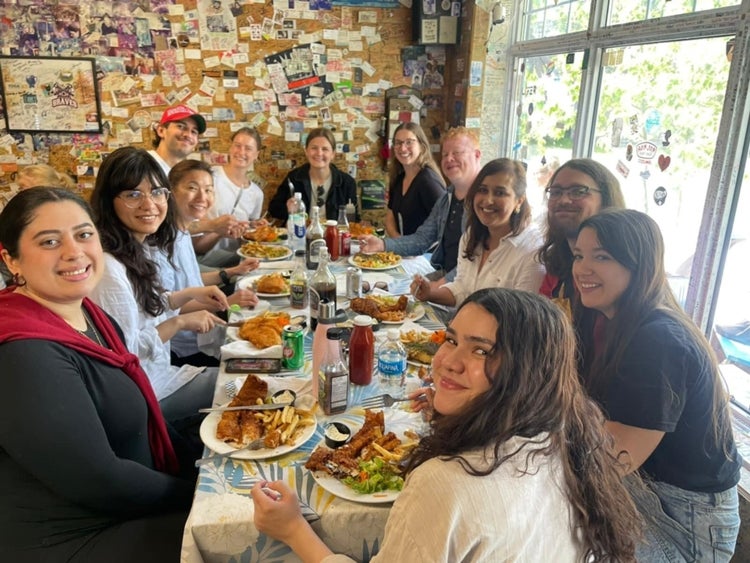U of T urban studies course explores wildfire response in Canada's North

Clouds of smoke billow into the air as forest fires burn in the Northwest Territories in 2015, leaving trees damaged and charred (photo by Sherry Galey via Getty Images)
Published: August 12, 2024
Wildfires such as the one that devastated Jasper, Alta., in July are becoming ever more common in Canada due to increased record-high temperatures and drought conditions associated with climate change.
One year ago, it was Yellowknife that found itself under threat, forcing a near-complete evacuation of its 20,000 residents. Unlike Jasper, Yellowknife's homes and businesses were ultimately saved from destruction, but the Northwest Territories capital is nevertheless reviewing its wildfire response plans so it will be better prepared in the future.
And the city is receiving valuable assistance from the University of Toronto.
Professors and graduate students from the urban studies program at Innis College recently visited the city to research disaster response policies and make suggestions on possible improvements.
“We ended up designing a course that provided a retrospective on the evacuation experience as it related to government officials and the non-profit sector,” says David Roberts, an associate professor, teaching stream, in the department of geography and planning in the Faculty of Arts & Science and director of the urban studies program.
“The students are now working on projects that will provide policy recommendations for the future.”

This seminar, which was also taught by Assistant Professor Aditi Mehta, is one of several Multidisciplinary Urban Graduate Seminars (MUGS) being offered by U of T’s School of Cities.
Roberts and Mehta created the class in consultation with Rebecca Alty, Yellowknife’s mayor and a visiting expert, or Canadian Urban Leader, at the School of Cities.
Mehta says that the seminar’s multidisciplinary nature was key to crafting a well-rounded response to the crisis.
“We were very deliberate in picking students from different disciplines so that we could create knowledge and think about what happened from different perspectives,” she says, adding that students who successfully applied came from backgrounds including geography and planning, forestry, anthropology, landscape architecture and public health.

The 10 graduate students visited sites and interviewed government officials, community organizations, residents and Indigenous leaders. They explored how to build improved communication infrastructure in the city and investigated the connections between a local housing crisis and climate change.
They also studied how Indigenous Peoples, including members of the Dene Nation living in Yellowknife, suffer disproportionate harms due to wildfire. Research shows that while 12 per cent of the entire Canadian population is at risk, that number rises to 32 per cent for on-reserve First Nations communities.
Léo Jourdan, who is completing his master of science degree in forestry at the John H. Daniels Faculty of Architecture, Landscape, and Design, says the seminar provided him with an opportunity to examine wildfire science from a different angle.
“The research we do in our lab has to do with wildfires, but from a scientific point of view – in the sense that we try to answer ecological questions about the origins of these fires. So this class was a great opportunity to broaden my perspective and learn more about the human side of wildfires, and I think it did an amazing job.”
Jourdan explains that most wildfires are a natural – and necessary – phenomenon. “A lot of the forest in Canada co-evolved with fires, and their ecosystems would not function without them,” he says. “The issue we’re facing now, however, is that the wildfires are getting more intense and the communities closer.”

For Lilian Dart, the course offered an opportunity to explore her twin interests in environmental justice and housing policy.
“One of the focuses was to look at how people experiencing homelessness were evacuated,” says Dart, a PhD student in the department of geography and planning.
She notes that in the wake of the wildfire evacuation, a team from professional services firm KPMG conducted an audit that revealed significant holes in the system that allowed vulnerable populations to fall through.
“People without housing, for example, did not have social safety supports that other people did,“ she says. “They also had comorbidities that affected their health, making them even more vulnerable.”
Dart’s final assignment for the course is a policy paper that examines this issue. “My recommendations are mostly to do with how the municipality can better support service organizations in their collaboration with one another. How can resources be co-ordinated? And how can people work together to ensure a more organized response?”
Jourdan, for his part, is proposing that Yellowknife adopt the principles of FireSmart, a national program that leads the development of programs and resources to help Canadians increase their resilience to wildfires.
Mehta says Yellowknife’s mayor provided the group from U of T with some recommendations of her own. “She gave an important critique of planning education in our country, noting that people rarely study the problems that cities in northern Canada are facing,” Mehta says. “Instead, we are overly focused on big cities like Toronto, Montreal and Vancouver.”
Roberts says that the policy recommendations written by Dart, Jourdan and the other students will be offered “not just to the mayor, but to everyone else we talked to – those working in the non-profit field and at the territorial level, as well as those who work with the Dene.
“We’re now thinking about other ways of presenting this information, such as returning to Yellowknife to ensure that the dialogue we’ve started is able to continue.”



